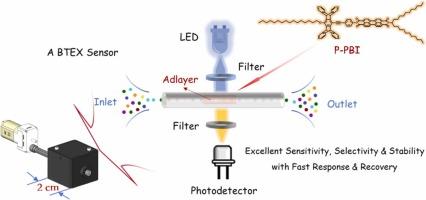高性能荧光BTEX传感器:薄膜器件优化与光学单元设计
IF 3.7
1区 化学
Q1 CHEMISTRY, ANALYTICAL
引用次数: 0
摘要
BTEX(苯、甲苯、乙苯和二甲苯)具有高度挥发性和致癌性,因此对其进行现场和实时监测至关重要。然而,现有的技术很难同时达到ppb级的灵敏度、快速反应和长期稳定性。为了解决这一挑战,我们开发了一种高性能的基于薄膜的荧光传感器,使用高荧光苝酰亚胺衍生物(P-PBI)作为传感材料。通过基于p- pbi的薄膜器件优化和改进的光学单元设计,我们的传感器实现了显著提高的信噪比(SNR),实现了超高灵敏度(苯:8.6 ppb,甲苯:2.3 ppb,乙苯:1.9 ppb,邻二甲苯:1.2 ppb,间二甲苯:2.0 ppb,对二甲苯:1.3 ppb),快速响应(<4 s)和快速恢复(<10 s)。此外,我们的传感器还具有出色的鲁棒性,可保持8个月以上的稳定性,并可承受1000次疲劳循环测试-优于通常与气相色谱(GC)和便携式光电离检测器(PID)相结合的火焰电离检测器(FID)。在加油站、粘合剂车间和公共吸烟区的现场测试进一步验证了传感器在现实场景中的可靠性。这项工作为现场和实时监测BTEX提供了方便的解决方案,对改善职业和环境安全具有重要意义。本文章由计算机程序翻译,如有差异,请以英文原文为准。

A high-performance fluorescence BTEX sensor: film device optimization and optical unit design
BTEX (benzene, toluene, ethylbenzene, and xylenes) are highly volatile and carcinogenic, making their on-site and real-time monitoring critical. Existing techniques, however, are hard to simultaneously achieve ppb-level sensitivity, rapid response, and long-term stability. To address this challenge, we developed a high-performance film-based fluorescence sensor using a highly fluorescent perylene bisimide derivative (P-PBI) as the sensing material. Through P-PBI-based film device optimization and improved optical unit design, our sensor achieves a significantly enhanced signal-to-noise ratio (SNR), enabling ultrahigh sensitivity (benzene: 8.6 ppb; toluene: 2.3 ppb; ethylbenzene: 1.9 ppb; o-xylene: 1.2 ppb; m-xylene: 2.0 ppb; p-xylene: 1.3 ppb), fast response (<4 s), and rapid recovery (<10 s). In addition, our sensor also demonstrates exceptional robustness, maintaining stability over eight months and enduring 1,000 fatigue cycles tests—outperforming flame ionization detectors (FID) generally coupled with gas chromatography (GC) and portable photoionization detectors (PID). Field tests in gas stations, adhesive workshops, and public smoking areas further validated the sensor’s reliability in real-world scenarios. This work provides a convenient solution for on-site and real-time BTEX monitoring, with significant implications for improving occupational and environmental safety.
求助全文
通过发布文献求助,成功后即可免费获取论文全文。
去求助
来源期刊

Sensors and Actuators B: Chemical
工程技术-电化学
CiteScore
14.60
自引率
11.90%
发文量
1776
审稿时长
3.2 months
期刊介绍:
Sensors & Actuators, B: Chemical is an international journal focused on the research and development of chemical transducers. It covers chemical sensors and biosensors, chemical actuators, and analytical microsystems. The journal is interdisciplinary, aiming to publish original works showcasing substantial advancements beyond the current state of the art in these fields, with practical applicability to solving meaningful analytical problems. Review articles are accepted by invitation from an Editor of the journal.
 求助内容:
求助内容: 应助结果提醒方式:
应助结果提醒方式:


